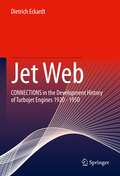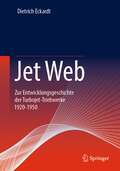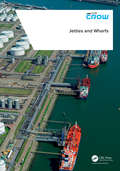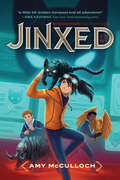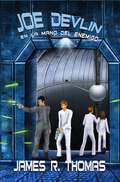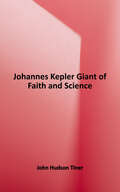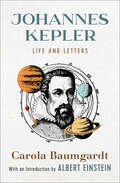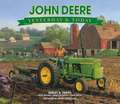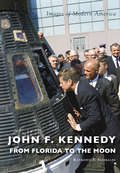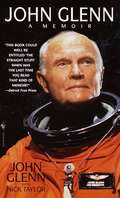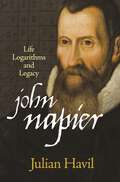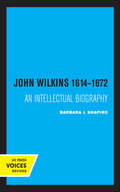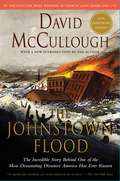- Table View
- List View
Jerome Lemelson: The Man Behind Industrial Robots (Little Inventor)
by Lucia RaatmaWhy is Jerome Lemelson important? His inventions helped create industrial robots, cassette players, and more! Readers follow his journey from struggling inventor to a multimillionaire with more than 600 patents. This story of determination is filled with engaging text and colorful images, all reviewed by Smithsonian experts.
Jerusalem Artichoke Food Science and Technology: Helianthus Tuberosus (Interdisciplinary Biotechnological Advances)
by Barbara Sawicka Barbara Krochmal-MarczakThis is the first book to explore the science underlying the Jerusalem artichoke, which is also known as Helianthus tuberosus L. and it is attracting increasing interest among food scientists and professionals worldwide. Due to a wide perspective for the production of inulin due to its high economic and ecological importance, the development of technologies for isolating and processing tuberous sunflower raw materials using environmentally friendly technologies (green chemistry and white biotechnology) and the global production of inulin shows an increasing tendency. Here we focus on the latest technological achievements related to the use of inulin in the food processing. In this book, readers will find full explanation of the conceptual aspects and the latest research results on a wide range of topics, including the relevant characteristics and applications from various fields. Written by leading scientists in the field, the book will be a valuable resource for students and researchers in the fields of food chemistry, nutritional science, physiology, and bioengineers, as well as for professionals in the food industry.
Jet Fire Due to Gas Leakage: Dynamical Theory and Risk Assessment (Springer Series in Reliability Engineering)
by Kuibin ZhouThis book presents a theoretical framework for the quantitative calculation of casualties and damage from jet fires caused by high-pressure gas leaks in pressure vessels or pipelines. The framework incorporates gas leakage models, combustion dynamics models, thermal radiation models, and thermal damage criteria. It conducts sensitivity and uncertainty analyses for the input parameters of the theoretical framework. The robustness of the theoretical framework is verified through field tests. Ultimately, the theoretical framework is used to quantitatively analyze the accidents involving jet fires due to the rupture of natural gas transmission pipelines. The sub-models within the theoretical framework are developed using the fundamental principles of thermodynamics, combustion, fluid dynamics, and heat transfer, and have been validated by small-scale laboratory tests. However, the theoretical framework receives the validation of field tests and real-world case studies. The theoretical deductions in this book offer significant guidance for scaling up from the laboratory experiments to field applications. The book is intended for anyone interested in understanding the risks associated with gas leaks and jet fires. The methodology enables the calculation of hazards for specific processes in isolation or their integration to assess overall consequences.
Jet Grouting: Technology, Design and Control
by Alessandro Flora Paolo Croce Giuseppe ModoniUnlike similar titles providing general information on ground improvement, Jet Grouting: Technology, Design and Control is entirely devoted to the role of jet grouting - its methods and equipment, as well as its applications. It discusses the possible effects of jet grouting on different soils and examines common drawbacks, failures and disadvantag
Jet Propulsion
by Nicholas Cumpsty Cumpsty, Nicholas and Heyes, Andrew Andrew HeyesThis is the second edition of Cumpsty's excellent self-contained introduction to the aerodynamic and thermodynamic design of modern civil and military jet engines. Through two engine design projects, first for a new large passenger aircraft, and second for a new fighter aircraft, the text introduces, illustrates and explains the important facets of modern engine design. Individual sections cover aircraft requirements and aerodynamics, principles of gas turbines and jet engines, elementary compressible fluid mechanics, bypass ratio selection, scaling and dimensional analysis, turbine and compressor design and characteristics, design optimization, and off-design performance. The book emphasises principles and ideas, with simplification and approximation used where this helps understanding. This edition has been thoroughly updated and revised, and includes a new appendix on noise control and an expanded treatment of combustion emissions. Suitable for student courses in aircraft propulsion, but also an invaluable reference for engineers in the engine and airframe industry.
Jet Propulsion: A Simple Guide to the Aerodynamic and Thermodynamic Design and Performance of Jet Engines
by Nicholas CumpstyThis is the second edition of Cumpsty's excellent self-contained introduction to the aerodynamic and thermodynamic design of modern civil and military jet engines. Through two engine design projects, first for a new large passenger aircraft, and second for a new fighter aircraft, the text introduces, illustrates and explains the important facets of modern engine design. Individual sections cover aircraft requirements and aerodynamics, principles of gas turbines and jet engines, elementary compressible fluid mechanics, bypass ratio selection, scaling and dimensional analysis, turbine and compressor design and characteristics, design optimization, and off-design performance. The book emphasises principles and ideas, with simplification and approximation used where this helps understanding. This edition has been thoroughly updated and revised, and includes a new appendix on noise control and an expanded treatment of combustion emissions. Suitable for student courses in aircraft propulsion, but also an invaluable reference for engineers in the engine and airframe industry.
Jet Transport Technique: Theory and Application
by Gerard Gómez Josep J. Masdemont Chen Gao Jianlin Chen Jianping Yuan Chuan MaThis book focuses on the Jet Transport (JT) technique and gives a systematic introduction on its theory development, algorithm implementation, and in particular, the applications in the field of astronautics including uncertainty propagation, filtering, as well as guidance and control. It features on the combination of mathematical theory and engineering applications, making the technique to be understood and mastered straightforwardly. Moreover, the JT-based methods proposed in the book offer a new and ingenious way to some classical problems. Given its breadth of coverage, the book offers a valuable reference guide for researchers and engineers interested in the JT methodology including theory and applications.
Jet Web: CONNECTIONS in the Development History of Turbojet Engines 1920 - 1950
by Dietrich EckardtThe present book describes the development history of turbojet engines, mainly in the web-type triangle Great Britain (USA) - Germany - Switzerland from early beginnings in the 1920s up to the first practical usage in the 1950s, before the still unbroken, grand impact of aero propulsion technology on global air traffic started. interconnections are highlighted, including the considerable impact of axial-flow compressor design know-how of the Swiss/German company BBC Brown Boveri & Cie. on both sides.The author reveals significant undercurrents which led to a considerable exchange, and thus change in understanding of the technical-historical perspective, especially in the decisive years before WWII, and thus closes gaps in the unilateral views of this ground-breaking technical advancement. The old ‘Whittle vs. von Ohain Saga’ is not repeated in full, but addressed in sufficient detail to understand the considerably enlarged narrative scope.
Jet Web: Zur Entwicklungsgeschichte der Turbojet-Triebwerke 1920-1950
by Dietrich EckardtDas vorliegende Buch beschreibt die Entwicklungsgeschichte der Turbo-Luftstrahltriebwerke, hauptsächlich im Beziehungsdreieck Großbritannien (USA) – Deutschland – Schweiz von frühen Anfängen in den 1920er Jahren bis zu ersten zivilen Anwendungen in den späten 1950er Jahren, ehe der bis heute anhaltende Siegeszug des Welt-Luftverkehrs begann. Unerwartete Verbindungen werden hervorgehoben, insbesondere der beträchtliche Einfluss der Axialverdichter-Technologie des schweizerisch-deutschen Unternehmens BBC Brown Boveri & Cie. auf die beiden anderen Seiten.Der Autor deckt wichtige Beziehungen und Abhängigkeiten auf, die einen erheb-lichen technischen Austausch förderten, und daher zu einer Änderung der bisherigen technisch-historischen Betrachtungsweise führen müssen, insbesondere in den entscheidenden Jahren vor Beginn des Zweiten Weltkriegs. Damit werden bestehende Lücken in der bisher allzu einseitigen Sicht auf diesen technisch herausragenden Entwicklungsfortschritt geschlossen. Die überlieferte ‚Whittle vs. von Ohain Saga‘ wird nicht in Gänze wiederholt, aber insoweit angesprochen, wie es zum Verständnis des nunmehr erheblich erweiterten Geschichtsbilds erforderlich ist.
Jetpack Attack (Carmen Sandiego Chase-Your-Own Capers)
by Houghton Mifflin HarcourtJoin Carmen Sandiego and decide where in the world to go next in this globe-trotting, daring caper! Stop VILE from stealing the superior jetpack technology you&’ve developed and using it for nefarious deeds. With twenty possible endings, your adventures can take you all over the world—or out of the game. Which will you choose? In this choose-your-own-caper set in the world of Carmen Sandiego, you are unwittingly working as a technician developing a highly maneuverable jetpack for VILE. The prototype is almost complete when Carmen sneaks into your lab to steal it. That&’s when she tells you about VILE and their dastardly deeds. You decide to help Carmen try to keep this cutting-edge technology away from anyone who&’d use it as the ultimate thieving tool. Or do you? Twenty different possible endings keep readers coming back for more adventures with Carmen Sandiego!
Jetties and Wharfs
by CrowFor centuries, jetties and wharfs have been designed and built around the world and play an important role in contemporary ports. The difference in the use of jetties, piers and wharfs is that jetties are frequently used for the transhipment and storage of light materials and ro-ro traffic, while piers are generally used for heavy loads like iron ore. That is why piers are mostly designed and constructed like quay walls (which are beyond the scope of this handbook).The designs were originally based on trial and error and the insights of those who dared to conquer local conditions, such as wind, waves, currents and soil composition. Design and construction techniques have since evolved into the designs we see on the coast or in river ports and seaports nowadays.The purpose of this handbook is to provide insight and guidelines regarding aspects that are important in the design of jetties and wharfs. Jetty-specific issues such as loads, interfaces between materials, installations on jetties and wharfs, as well as detailing aspects, are also covered. This handbook is part of a series of Dutch port infrastructure design recommendations that include the Quay Walls handbook and Jetties and Wharfs handbook.
Jinxed (Jinxed #1)
by Amy McCullochThe Golden Compass meets the digital age! When a coding star enters an elite technology academy, she discovers a world of competition, intrigue, and family secrets—plus a robotic companion that isn't what it seems.Lacey Chu is a girl who codes. She has always dreamed of working as an engineer for MONCHA, the biggest tech firm in the world and the company behind the "baku"—a customizable "pet" with all the capabilities of a smartphone. But when Lacey is rejected by the elite academy that promises that future, she's crushed.One night, Lacey comes across the broken form of a highly advanced baku. After she repairs it, the cat-shaped baku she calls Jinx opens its eyes and somehow gets her into her dream school. But Jinx is different than any other baku she's ever seen…He seems real.As Lacey settles into life at school, competing with the best students in a battle of the bakus that tests her abilities, she learns that Jinx is part of a dangerous secret. Can Lacey hold on to Jinx and her dreams for the future?Jinxed is the perfect…middle grade book for girls who are passionate about codingsummer reading chapter book for kids 9-12science fiction book for kids 9-12engineer academy bookrobot book for kids"With a sharp eye toward the rising awareness of device addiction and a keen sense of wonder, McCulloch's tale is a feast for the imagination that celebrates women in STEM fields."—Publisher's Weekly, STARRED review"I raced through this book…a little bit Golden Compass and all adventure."—Amie Kaufman, New York Times bestselling author
Joe Devlin: En la manos del enemigo (Serie Academia Espacial #4)
by James R. ThomasEn el Libro Cuatro de la Serie de la Academia Espacial, la Fuerza Espacial Intergaláctica busca venganza después de ser atacada por un enemigo misterioso. ¿Han unido los turianos fuerzas con un nuevo adversario para exigir su propia venganza? ¿Debería la ISF contraatacar? Mientras tanto, Joe lucha por luchar contra sus demonios de guerra mientras se prepara para embarcarse en una misión clandestina en busca de sus seres queridos. Con el poder del Black Medallion en sus manos, esta empresa puede conducir a la muerte de Joe, si su influencia no lo destruye primero. Ven y únete a Joe Devlin mientras comienza su viaje, ¡pero date prisa! Las cosas se pondrán difíciles rápidamente con paranoia y traición en cada esquina.
Joe Pawsey and the Founding of Australian Radio Astronomy: Early Discoveries, from the Sun to the Cosmos (Historical & Cultural Astronomy)
by Claire Hooker W. M. Goss Ronald D. EkersThis open access book is a biography of Joseph L. Pawsey. It examines not only his life but the birth and growth of the field of radio astronomy and the state of science itself in twentieth century Australia. The book explains how an isolated continent with limited resources grew to be one of the leaders in the study of radio astronomy and the design of instruments to do so. Pawsey made a name for himself in the international astronomy community within a decade after WWII and coined the term radio astronomy. His most valuable talent was his ability to recruit and support bright young scientists who became the technical and methodological innovators of the era, building new telescopes from the Mills Cross and Chris (Christiansen) Cross to the Parkes radio telescope. The development of aperture synthesis and the controversy surrounding the cosmological interpretation of the first major survey which resulted in the Sydney research group's disagreements with Nobel laureate Martin Ryle play major roles in this story. This book also shows the connections among prominent astronomers like Oort, Minkowski, Baade, Struve, famous scientists in the UK such as J.A. Ratcliffe, Edward Appleton and Henry Tizard, and the engineers and physicists in Australia who helped develop the field of radio astronomy. Pawsey was appointed the second Director of the National Radio Astronomy Observatory (Green Bank, West Virginia) in October 1961; he died in Sydney at the age of 54 in late November 1962. Upper level students, scientists and historians will find the information, much of it from primary sources, relevant to any study of Joseph L. Pawsey or radio astronomy.This is an open access book.
Johannes Kepler (SparkNotes Biography Guide)
by SparkNotesJohannes Kepler (SparkNotes Biography Guide) Making the reading experience fun! SparkNotes Biography Guides examine the lives of historical luminaries, from Alexander the Great to Virginia Woolf. Each biography guide includes:An examination of the historical context in which the person lived A summary of the person&’s life and achievements A glossary of important terms, people, and events An in-depth look at the key epochs in the person&’s career Study questions and essay topics A review test Suggestions for further reading Whether you&’re a student of history or just a student cramming for a history exam, SparkNotes Biography guides are a reliable, thorough, and readable resource.
Johannes Kepler: Giant of Faith and Science (Sower Ser.sower Series Biographies)
by John Hudson TinerA bibliography of the German astronomer who discovered three laws of planetary motion.
Johannes Kepler: Life and Letters
by Carola BaumgardtWith an introduction by Albert Einstein: The collected letters of the Renaissance astronomer who discovered the laws of planetary motion. Astronomer and mathematician Johannes Kepler made major contributions to the Scientific Revolution of the seventeenth century. While his achievements are well-documented elsewhere, this volume of his personal correspondence offers a rare window into the life of a man who pursued knowledge through a dangerous and turbulent period of history. Spanning more than thirty years, from 1596 to the end of his life, Kepler&’s letters reveal the internal conflicts of a devout Protestant who nevertheless opposed many pronouncements of the Church, an eminent man of science who was also swayed by astrology, and a contemporary of Galileo who served three succeeding Holy Roman Emperors.
John B. Herrington
by Stacia Deutsch Rhody CohonEach book in the "Sharing the American Dream: Overcoming Adversity" series features a biography of the challenges these people faced during their lives. The series is interesting, lively, accurate, factual, and up-to-date. Information about each celebrity's personal lives and romantic relationships, in addition to his or her professional achievements is included, as well as individual philanthropic efforts.
John Deere Yesterday and Today
by Robert N. PrippsCelebrate the history of a beloved American brand that has become familiar to generations of farming families. Follow this iconic agricultural company from the early 1800s, when John Deere himself devised a plow blade in his blacksmith shop, through the automation of the two-cylinder tractor nearly 100 years later, and into the 21st century of advanced technology and the future of farming equipment. This hardcover book includes an eye-catching cover and beautiful four-color photos and illustrations, many of which feature John Deere memorabilia-such as a commemorative Barbie doll-down through the years.
John F. Kennedy: from Florida to the Moon (Images of Modern America)
by Raymond P. SinibaldiIt was September 12, 1962, when Pres. John F. Kennedy delivered a speech at Rice University before nearly 50,000 people. By that time, America had launched but four men into space--the suborbital flights of Alan Shepard and Gus Grissom and the nearly identical three-orbit journeys of John Glenn and Scott Carpenter. Buoyed by the success of those missions and cognizant of the danger that lay ahead, the president rearticulated his vision and reissued his challenge to reach the moon before 1970. "We choose to go to the moon, in this decade and do the other things, not because they are easy, but because they are hard. Because that goal will serve to organize and measure the best of our energies and skills." The assassination of President Kennedy, in the words of flight director Gene Kranz, turned his vision into a "quest to do it and do it in the time frame he allotted." On July 20, 1969, Neil Armstrong stepped off the ladder of the lunar module known as Eagle, taking "one small step for man, one giant leap for mankind."
John Glenn: A Memoir
by John Glenn Nick TaylorHe was the first astronaut to orbit the Earth. Nearly four decades later, as the world's oldest astronaut, his courage riveted a nation. But these two historical events only bracketed a life that covers the sweep of an extraordinary century. John Glenn's autobiography spans the seminal events of the twentieth century. It is a story that begins with his childhood in Ohio where he learned the importance of family, community, and patriotism. He took these values with him as a marine fighter pilot during World War II and into the skies over Korea, for which he would be decorated. Always a gifted flier, it was during the war that he contemplated the unlimited possibilities of aviation and its frontiers. We see the early days of NASA, where he first served as a backup pilot for astronauts Alan Shepard and Gus Grissom. In 1962 Glenn piloted the Mercury-Atlas 6 Friendship 7 spacecraft on the first manned orbital mission of the United States. Then came several years in international business, followed by a twenty-four year career as a U. S. Senator-and in 1998 a return to space for his remarkable Discover mission at the age of seventy-seven.
John Glenn: Around the World in 90 Minutes
by Paul WestmanA biography of the first American to orbit the earth who is now a United States Senator from his native Ohio.
John Napier: Life, Logarithms, and Legacy
by Julian HavilThe most comprehensive account of the mathematician's life and workJohn Napier (1550–1617) is celebrated today as the man who invented logarithms—an enormous intellectual achievement that would soon lead to the development of their mechanical equivalent in the slide rule: the two would serve humanity as the principal means of calculation until the mid-1970s. Yet, despite Napier's pioneering efforts, his life and work have not attracted detailed modern scrutiny. John Napier is the first contemporary biography to take an in-depth look at the multiple facets of Napier’s story: his privileged position as the eighth Laird of Merchiston and the son of influential Scottish landowners; his reputation as a magician who dabbled in alchemy; his interest in agriculture; his involvement with a notorious outlaw; his staunch anti-Catholic beliefs; his interactions with such peers as Henry Briggs, Johannes Kepler, and Tycho Brahe; and, most notably, his estimable mathematical legacy.Julian Havil explores Napier’s original development of logarithms, the motivations for his approach, and the reasons behind certain adjustments to them. Napier’s inventive mathematical ideas also include formulas for solving spherical triangles, "Napier’s Bones" (a more basic but extremely popular alternative device for calculation), and the use of decimal notation for fractions and binary arithmetic. Havil also considers Napier’s study of the Book of Revelation, which led to his prediction of the Apocalypse in his first book, A Plaine Discovery of the Whole Revelation of St. John—the work for which Napier believed he would be most remembered.John Napier assesses one man’s life and the lasting influence of his advancements on the mathematical sciences and beyond.
John Wilkins 1614-1672: An Intellectual Biography
by Barbara J. ShapiroThis title is part of UC Press's Voices Revived program, which commemorates University of California Press’s mission to seek out and cultivate the brightest minds and give them voice, reach, and impact. Drawing on a backlist dating to 1893, Voices Revived makes high-quality, peer-reviewed scholarship accessible once again using print-on-demand technology. This title was originally published in 1969.
Johnstown Flood: The Incredible Story Behind One Of The Most Devastating "natural" Disasters America Has Ever Known
by David McCulloughThe stunning story of one of America’s great disasters, a preventable tragedy of Gilded Age America, brilliantly told by master historian David McCullough.At the end of the nineteenth century, Johnstown, Pennsylvania, was a booming coal-and-steel town filled with hardworking families striving for a piece of the nation’s burgeoning industrial prosperity. In the mountains above Johnstown, an old earth dam had been hastily rebuilt to create a lake for an exclusive summer resort patronized by the tycoons of that same industrial prosperity, among them Andrew Carnegie, Henry Clay Frick, and Andrew Mellon. Despite repeated warnings of possible danger, nothing was done about the dam. Then came May 31, 1889, when the dam burst, sending a wall of water thundering down the mountain, smashing through Johnstown, and killing more than 2,000 people. It was a tragedy that became a national scandal. Graced by David McCullough’s remarkable gift for writing richly textured, sympathetic social history, The Johnstown Flood is an absorbing, classic portrait of life in nineteenth-century America, of overweening confidence, of energy, and of tragedy. It also offers a powerful historical lesson for our century and all times: the danger of assuming that because people are in positions of responsibility they are necessarily behaving responsibly.






